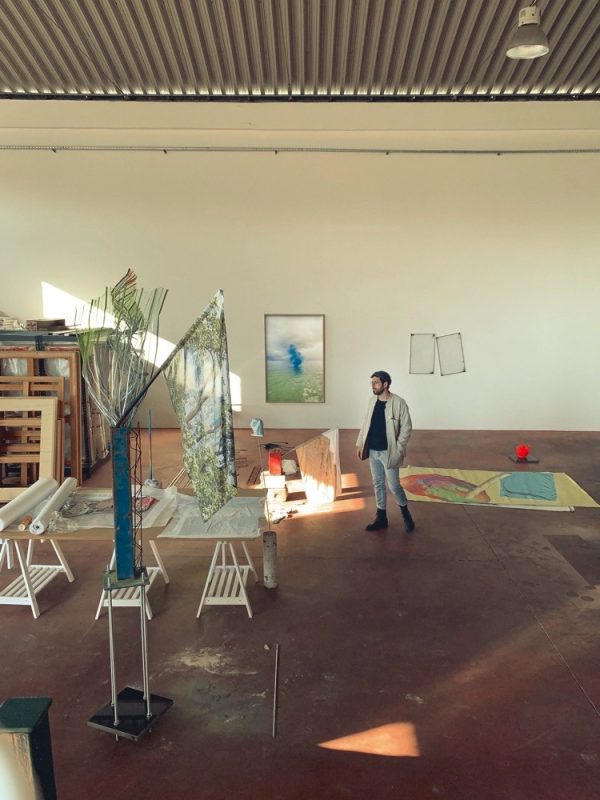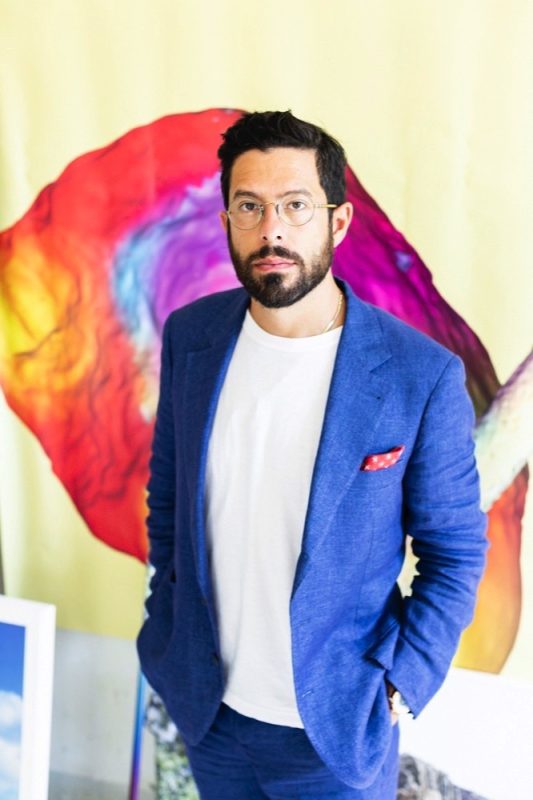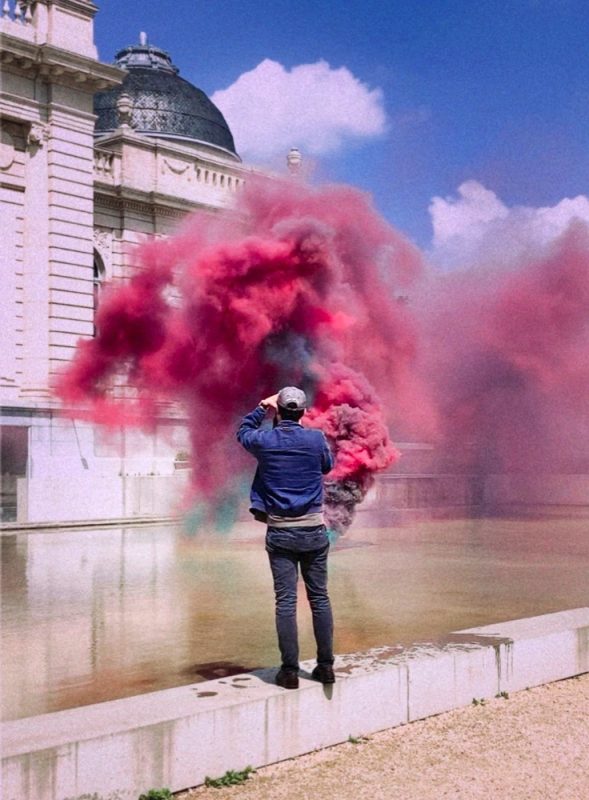Filippo Minelli is an Italian artist who creates performances and installations. The author focuses his view on the study of the interaction of landscape and society. The main themes of the artist’s work are the study of politics from the side of anthropology, the decontextualization of the use of smoke substances, and the change in the function of flags. We talked to the artist about the growth of digital art in representing him Inloco Gallery‘s Metaverse space.
DubaiGlobalNews: When did you start creating art and how did you incorporate digital art into your artistic experience?
Filippo Minelli: I have been working as a professional artist for over 20 years, and I am currently 40 years old. When it comes to digital art, it depends on how you view artistic movements and what has happened in contemporary art over the last 50 years or so. Digital art is a vast and diverse movement, which originated with the creation of the Internet. Some artists focused on working with Internet infrastructure and coding, while others were mostly working online. Nowadays, digital art has evolved into new forms such as graphic design, 3D and web design. So, it is safe to say that what you are referring to is a newer approach to art.

If you want to focus on what has been done in the last 10 years, for sure, it’s more focused on interaction and performative approaches. And that’s why, for example, you have exhibitions like this one that has been created not in an art gallery in the beginning but has been created in a public space, also very difficult to document and to work in and then has been brought back into a normal gallery venue. This is what also technology allows us to do.
DubaiGlobalNews: Is technology or traditional means better for promoting art? Do traditionalists prefer print or digital?
Filippo Minelli: I think it’s a very different approach. Some artists are working with paint and artists that are working with digital art, and they both have their reason to use one media or another. It’s not that every artist should switch to digital just because it’s there. Being an artist means that you know what you’re doing and there’s a precise reason why you are using one media or another. For sure, what is interesting about technology is that right now everyone has a phone or a computer that uses daily.
So, it allows artists to reach a wider audience and sometimes also an audience that is not necessarily very accustomed to art. You broaden the spectrum of spectators, which can be both good and bad, depending on what’s the goal of the exhibition, for sure.
DubaiGlobalNews: Okay, something more about digital art. Do you think that it has the sense or the soul of real art? And how we can pass this sense?
Filippo Minelli: Even in paint it has always been the question with contemporary art that at some point someone comes up and says: “I could have done it”. But the thing is that you didn’t do it. And if you didn’t do it, there’s a reason for it. And there’s a reason why somebody else has done it. So what’s important about art is not necessarily the technique or what you call the personal style. It’s not about aesthetics, but it’s about the meaning of things.
It’s about the reasons why you decide to realize that specific idea. And it’s about the idea itself. So for sure, with technology and digital tools, there’s also the risk of creating artworks that can be replicable, reproduced in many different ways, or have a similar aesthetic.

Although all the contemporary artists are recognized as such and have a history in digital art, they all have their own very clear focus and approach to research and to realization and
their precise meanings in what they do. So if this is an issue, it’s an issue of contemporary art in general and not only of digital art.
DubaiGlobalNews: What challenges did you face when transitioning from traditional to digital art, and how did you overcome them?
Filippo Minelli: When I started at the Brera Art Academy in Milan, it was already almost 20 years ago, I got my formation in the new media art department. So they were already teaching us all the software and methods to explore spaces digitally or to deploy digital tools in public spaces. So it was part of my very formation since the early days.
But yes, there are a lot of very technical aspects that you have to know about, at least to understand the tool that you’re using. And the main problem is finding the right audience because so far the right audience for digital art is the same as for contemporary art.
So sometimes having a lot of people not involved in the artwork, even if it’s a broader audience, doesn’t mean that in a qualitative term, it can be successful because of the message that can or can’t be articulated through what you do.
But for sure, when you talk about technology, there are a lot of technical aspects that you have to learn or that you have to commission to somebody else if you want to have them realized by somebody else who’s more professional in technical aspects than you are. This is not a new thing, because also artists from the Renaissance were commissioning paintings to their assistants and they had studios with 10-20 people working for them.
DubaiGlobalNews: How do you think digital art has improved the art of the art science for people?
Filippo Minelli: Well, it helps for sure because now more people have access to technological devices, and more people, especially younger generations are more used to the kind of aesthetic that is used on digital devices nowadays. Through these media, it’s possible to enlarge the audience of people interested in art.
The current challenge lies in the fact that digital art or art in general is occasionally restricted to particular events, rather than being consistently showcased as a form of spectacle. Regrettably, certain digital art initiatives lack substantial cultural significance in the contemporary landscape. This is compounded by the prevalence of spectacle-oriented approaches, which are often employed to attract a larger audience engagement.
Besides these very specific events, the rest can be very interesting to enlarge the audience attending exhibitions both in the digital space or art created with digital tools in regular galleries and museums.
DubaiGlobalNews: Does this mean that anyone interested in becoming an artist can start with digital art? Do you believe it can assist anyone or only those with real artistic talent?
Filippo Minelli: Well, I think that through digital tools especially through artificial intelligence there are a lot of people that can generate new visual elements. This doesn’t mean that these visual creations are necessarily art. Sometimes they look nice they are aesthetically appealing. But contemporary art since we know it for more than 100 years almost is not just about aesthetics but it’s about ideas, it’s about meanings.
It’s about interacting with society and also challenging some of our perceptions of reality that we have at the moment. Everyone can use digital tools to create art but if they don’t use their brain and they don’t know why they are creating these works it’s difficult to call it art. It can be called just decoration or just entertainment but if there’s no reason for it to exist in a broader cultural context probably it’s not to be called art.

It doesn’t mean that it shouldn’t exist as curators and art historians exist exactly for this reason to be able to select and help us understand what is historically relevant and what is just very temporary or unnecessary even so it’s going to be their job to guide us through what makes sense in cultural terms in this new field of contemporary art.
DubaiGlobalNews: How many digital exhibitions do you have?
Filippo Minelli: Three or four so far. I also work a lot with sculpture, photography, and painting. In these last 20 years, the majority of exhibitions were traditional exhibitions in traditional exhibition spaces, like galleries, foundations, and museums. And for sure, this is the first one that I had in Dubai.
DubaiGlobalNews: What do you discover through the journey of your digital exhibitions?
Filippo Minelli: The journey in terms of works didn’t change so much because my focus is always on landscape and how we can see the interaction between the natural world and the digital world. But there was for sure a journey in terms of technology because 10 years ago, technology was not as advanced as it is right now. And even just in 2019, it wasn’t that advanced.
I think that during COVID, with all the developers stuck somewhere, working and working and working and trying to find ways to show art that was not possible to be seen anymore in real life, this kind of software and technology allows people to experience art had a massive boost from 2020 until 2022. So, the journey was mostly technological.
Before, some artists were not even digital artists – they didn’t even show images. They released computer code that was not generating an image. Right now, it’s incredibly fluid. Everything is optimized for laptops, tablets, and smartphones.
The more technology and the speed of connection improve, the more opportunities there will be for artists, especially the ones working with 3D imaging and videos and like heavier files that are more difficult to be used for fruition online.
DubaiGlobalNews: Do you have any advice for artists and viewers when it comes to the intersection of technology and classical art?
Filippo Minelli: My advice is to use your brain to understand why you are creating something and choose the medium that best fits your idea. Don’t limit yourself to photography if your idea would be better realized as a sculpture or digital artwork. Avoid following trends or temporary hypes and instead focus on what you are doing and the best way to execute it. Think critically and choose the medium that will bring your idea to life in the most effective way.
DubaiGlobalNews: Where do you think technology will be in the next 2-3 years? What are your expectations?
Filippo Minelli: Honestly, I wouldn’t know because there’s a lot of progress going on, on different levels and different kinds of technology. I hope that it will not go in the direction of virtual reality, that it’s still very annoying for me, or at least it’s still very backward in fruition. So, if I have to pick something, it’s not VR.
DubaiGlobalNews: Does it mean you support classical art more?
Filippo Minelli: No, not really. It’s just a matter of coherence of the tools you use to create art and how pleasant the interaction to experience art is. For example, I love to find myself in an empty room with a fantastic painting and I love to experience digital art easily on a laptop. But if the user experience for some artworks is too complicated or too annoying, of course, it removes part of the emotional experience that you have when experiencing art.
I don’t necessarily favor traditional art over other forms, but I believe it’s crucial to consider the quality of the artwork, its context, and the situation in which it’s viewed. The experience of viewing a painting in an empty room is vastly different from that of viewing a poorly executed one amidst a crowd or while being distracted by other things. Unfortunately, technology doesn’t always provide the optimal context for experiencing art.
DubaiGlobalNews: What are your words of wisdom for professional artists?
Filippo Minelli: To continue advancing contemporary art and increase participation in cultural fields that are currently lacking resources, it is important to stay active and engaged with society. This is particularly important in the Western world. Because we already have a lot of information, we have a lot of things, maybe too much. Contemporary art provides an opportunity to take a step back and reflect on ourselves, our lives, and society as a whole. It would be amazing if artists could continue creating and engaging with a larger part of society.
DubaiGlobalNews: Thank you very much! We wish you continued success!
Filippo Minelli: Thank you for this! And I hope to meet you the next time in Dubai.
DubaiGlobalNews: Inshallah, see you in Dubai.




















